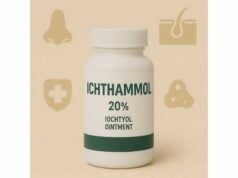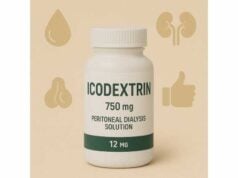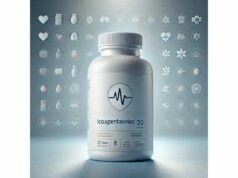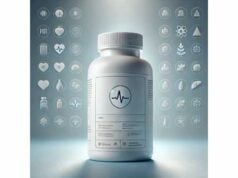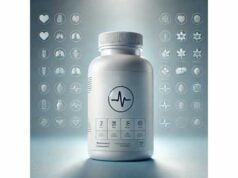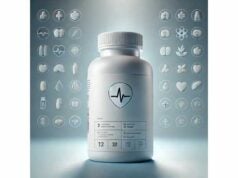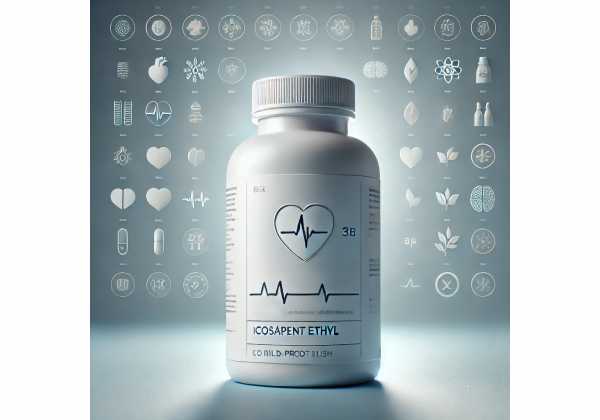
Icosapent ethyl is a prescription, highly purified form of the omega-3 fatty acid eicosapentaenoic acid (EPA). It is used to lower high triglycerides and—importantly—to reduce cardiovascular event risk in select adults who are already on statins but still have persistently elevated triglycerides. Unlike general “fish oil” mixes that combine EPA and DHA, icosapent ethyl delivers EPA alone at a therapeutic dose studied in large outcome trials. EPA integrates into cell membranes, shifts inflammatory signaling toward resolution, and curbs liver production of triglyceride-rich lipoproteins. For the right person, it can be a powerful add-on to foundational therapies like statins, blood pressure control, glucose management, and lifestyle change. This guide explains how it works, who benefits, how to use it alongside food choices and other medications, how to dose and monitor it, what to watch for with side effects, and how to talk with your clinician about real-world risks and benefits.
Key Insights
- In statin-treated adults with triglycerides roughly 135–499 mg/dL, icosapent ethyl at 4 g/day can reduce major cardiovascular events.
- Standard prescription dosing is 2 g twice daily with food (total 4 g/day).
- Main cautions: bleeding tendency and a small increase in atrial fibrillation risk; monitor if on anticoagulants or with arrhythmia history.
- Avoid or use only with specialist guidance in pregnancy, active bleeding, severe fish/shellfish allergy, or uncontrolled arrhythmias.
Table of Contents
- What icosapent ethyl is and how it works
- Who benefits and where it helps most
- How to use it with food and therapies
- Dosing, monitoring, and practical examples
- Safety, side effects, and who should avoid
- Evidence, FAQs, and clinical checklist
What icosapent ethyl is and how it works
Definition and composition
Icosapent ethyl is the ethyl ester of eicosapentaenoic acid (EPA), a long-chain omega-3 fatty acid. Once absorbed, it is hydrolyzed to free EPA, which circulates and incorporates into cell membranes across the vascular, immune, and metabolic systems. The product is highly purified, meaning it is EPA-only, not a mixture of EPA and DHA (docosahexaenoic acid). This distinction matters because therapeutic effects, lipid changes, and clinical outcomes differ between EPA-only and mixed omega-3 formulations.
How EPA reshapes lipid metabolism
The liver packages triglycerides into very-low-density lipoproteins (VLDL). EPA reduces hepatic triglyceride synthesis and VLDL assembly, while enhancing clearance of triglyceride-rich remnants. This can produce meaningful reductions in fasting triglycerides, typically larger when baseline triglycerides are high. In practice, lowering triglycerides helps reduce pancreatitis risk when levels are severely elevated and may also diminish atherogenic remnant particles that drive plaque growth.
Inflammation, resolution, and vascular biology
EPA competes with arachidonic acid (AA) for cyclooxygenase and lipoxygenase enzymes, shifting the balance from pro-thrombotic and pro-inflammatory mediators toward less-inflammatory prostaglandins, leukotrienes, and specialized pro-resolving mediators (resolvins). This biochemical shift can translate into improved endothelial function, reduced plaque inflammation, and greater plaque stability—one proposed explanation for event reduction seen in high-risk patients already on statins.
EPA versus DHA—why “just EPA” can be different
DHA is vital in neural and retinal structure, but at therapeutic doses in mixed oils it can modestly raise LDL-C in some individuals. EPA-only therapy generally does not raise LDL-C and has been tested head-to-head in outcome settings where background statins were optimized. Therefore, EPA-only data cannot be assumed for mixed EPA+DHA products, even if the total milligrams of “omega-3” look similar on a label.
Formulations you may encounter
- Prescription icosapent ethyl: Standardized, purified EPA in 0.5 g or 1 g capsules, dosed to 4 g/day.
- Dietary fish intake: Salmon, sardines, mackerel, trout, and herring provide EPA and DHA as part of a heart-healthy diet, but typical servings rarely deliver the therapeutic 4 g/day of EPA used in outcome trials.
- OTC fish oil supplements: Highly variable EPA content per capsule and often combined with DHA; quality and oxidation control differ by brand.
Where it fits in care
Think of icosapent ethyl as a targeted adjunct for residual triglyceride-related risk in high-risk adults who remain on statins. It is not a replacement for statins, blood pressure management, glucose control, tobacco cessation, or diet and physical activity. Rather, it complements these foundations by acting on a different risk pathway.
Who benefits and where it helps most
1) Statin-treated adults with persistent hypertriglyceridemia
The clearest benefit appears in adults with established atherosclerotic cardiovascular disease (ASCVD) or diabetes with additional risk factors who, despite maximally tolerated statins, have triglycerides roughly 135–499 mg/dL. In this group, prescription EPA at 4 g/day reduced major adverse cardiovascular events compared with placebo. Absolute benefit is greatest when baseline risk is higher—older age, prior events, polyvascular disease, or multiple risk factors.
2) Patients with severe hypertriglyceridemia
When fasting triglycerides are ≥500 mg/dL, pancreatitis risk becomes a central concern. Icosapent ethyl, lifestyle measures (lower refined carbohydrates and alcohol), and sometimes fibrates or insulin optimization (in diabetes) are used to quickly lower triglycerides. After the immediate risk eases, the long-term plan pivots to durable risk reduction and weight, glycemia, and blood pressure control.
3) People with remnant cholesterol concerns
Remnant cholesterol (cholesterol in triglyceride-rich lipoproteins) contributes to atherosclerosis. EPA’s ability to reduce triglyceride-rich remnants and improve non-HDL-C can help certain patients whose LDL-C is controlled but whose non-HDL-C remains elevated.
4) Adults intolerant of DHA-containing products
Some individuals experience LDL-C elevations or GI intolerance with mixed EPA+DHA oils. EPA-only therapy may avoid the LDL-C rise and is often better tolerated at the prescribed regimen, particularly when taken with meals.
Contexts where benefit is limited or unclear
- Primary prevention at low risk: If ASCVD risk is low and triglycerides are normal, the absolute benefit of icosapent ethyl is likely small; focus on diet, activity, sleep, and standard risk-factor control.
- Cognition or eye health as primary goals: EPA supports cell membrane health, but robust outcome data for EPA-only in cognition or vision are limited; DHA-dominant strategies are typically explored for those aims through diet or separate supplements.
- Replacing foundational care: Icosapent ethyl does not substitute for statins, antihypertensives, SGLT2 inhibitors or GLP-1 receptor agonists (in diabetes), or smoking cessation.
How to identify candidates quickly (clinical snapshot)
- Yes, consider: On statin therapy; triglycerides persistently ≥135 mg/dL on repeat testing; established ASCVD or diabetes with risk factors; no uncontrolled bleeding or arrhythmias; shared decision-making supports add-on therapy.
- Maybe: CKD, older age, polypharmacy—benefit possible, but monitoring and coordination are key.
- No or defer: Pregnancy, active bleeding, upcoming high-risk surgery without a plan, severe fish/shellfish allergy without specialist input, uncontrolled atrial fibrillation.
Equity and access
Prescription EPA can be costly. If coverage is a barrier, clinicians may document statin use, triglyceride levels, and risk profile to support prior authorization. For those unable to access it, prioritize aggressive lifestyle therapy and optimization of proven cardiometabolic medications while exploring assistance programs.
How to use it with food and therapies
Build on a dietary foundation
Two fish meals per week is a reasonable baseline for most adults and aligns with heart-healthy eating patterns. Emphasize low-mercury fish (salmon, sardines, trout), abundant vegetables, legumes, whole grains, nuts, and olive oil. This dietary matrix complements the anti-inflammatory and lipid-modulating actions of EPA and supports weight and glycemic control.
Taking icosapent ethyl correctly
- Dose with meals: Standard dosing is 2 g twice daily with food. Taking it with meals improves absorption and reduces fishy belching.
- Be consistent: Benefits accrue with steady daily use alongside statins and lifestyle measures. Sporadic dosing reduces efficacy.
- If you miss a dose: Take it with the next meal unless it is close to the next scheduled dose. Do not double up.
Working alongside key therapies
- Statins: Remain the backbone for LDL-C lowering and event reduction. Icosapent ethyl acts on residual triglyceride and inflammatory pathways.
- Antiplatelets/anticoagulants: EPA can modestly increase bleeding tendency. Clinicians may adjust monitoring around surgeries or dental procedures and review bruising, nosebleeds, or gum bleeding.
- Antihyperglycemics (GLP-1 RAs, SGLT2 inhibitors): For diabetes, these drugs reduce cardiovascular and renal events. EPA complements them by targeting triglyceride-rich lipoproteins; coordinate therapy to meet multiple risk goals simultaneously.
- Fibrates/niacin: Sometimes used for severe hypertriglyceridemia; co-administration requires careful monitoring of lipids, liver enzymes, and side effects.
OTC fish oil and quality questions
If you use non-prescription omega-3s for general wellness, read labels carefully: many list total “fish oil” but only a fraction is EPA. Quality varies in purity and oxidation; third-party testing is a plus. However, do not assume OTC products replicate the EPA-only, 4 g/day outcome evidence tied to icosapent ethyl.
Lifestyle synergies that amplify benefit
- Weight management: Even 5–10% weight loss can lower triglycerides and improve insulin sensitivity.
- Carbohydrate quality: Replace refined carbs and added sugars with fiber-rich foods; excess fructose is a potent driver of hepatic triglyceride synthesis.
- Alcohol: Moderate to none, especially if triglycerides are high; alcohol spikes hepatic VLDL output.
- Physical activity: Aim for at least 150 minutes/week of moderate activity plus strength training; exercise improves triglyceride clearance and HDL function.
- Sleep and stress: Poor sleep and chronic stress worsen cardiometabolic risk; address both as part of comprehensive care.
Dosing, monitoring, and practical examples
Standard dosing
- Prescription dose: 4 g/day as 2 g twice daily with food. Capsules are typically 1 g each (two per dose) or 0.5 g (four per dose). Swallow whole; do not crush or split unless the product information allows.
Titration and duration
There is no routine “titration” phase; clinicians start at the therapeutic dose. Duration is long-term for risk reduction, evaluated periodically for ongoing indication, tolerability, and adherence.
Monitoring plan (first year)
- Baseline: Fasting lipid panel, ASCVD risk profile, arrhythmia history, medication list (anticoagulants, antiplatelets, herbals), and bleeding history.
- 6–12 weeks: Re-check lipids to confirm triglyceride response and review side effects.
- Every 3–6 months: Assess adherence, new symptoms (palpitations, easy bruising, nosebleeds), and any procedure plans.
- Annually: Revisit the indication (e.g., still elevated triglycerides, high risk), overall risk control (LDL-C, blood pressure, A1C), and lifestyle progress.
Real-world scenarios
- Established ASCVD with residual high triglycerides
- 64-year-old on high-intensity statin; LDL-C 58 mg/dL; triglycerides 210 mg/dL; non-HDL-C remains elevated. Add icosapent ethyl 4 g/day. Counsel on bleeding signs, AF symptoms, and taking with meals. Recheck lipids in 8–12 weeks; continue long-term if tolerated and indicated.
- Diabetes with mixed dyslipidemia
- 58-year-old with type 2 diabetes on a statin and GLP-1 RA; triglycerides 320 mg/dL; A1C 7.8%. Start icosapent ethyl 4 g/day plus carbohydrate quality improvements and alcohol restriction. Consider a short-term fibrate only if triglycerides remain dangerously high; reassess after glucose optimization.
- Severe hypertriglyceridemia with pancreatitis risk
- 45-year-old with triglycerides 980 mg/dL and fatty liver. Implement very-low-refined-carb diet, limit alcohol, treat secondary causes (e.g., hypothyroidism), and start icosapent ethyl 4 g/day. If needed, add a fibrate temporarily to reduce immediate risk; reassess in 4–6 weeks.
Handling missed doses and travel
- Keep a small supply in your bag. If you miss a dose, take it with the next meal unless it’s close to the next scheduled dose; do not double.
What a “good response” looks like
- Triglycerides: Often down 15–30% (more if baseline is very high).
- Non-HDL-C/apoB: Modest reductions can occur in parallel with triglyceride changes.
- Clinical events: Risk reduction is population-level; individuals may not “feel” the benefit. Stay focused on adherence and global risk management.
Safety, side effects, and who should avoid
Common side effects (usually mild)
- Gastrointestinal: Dyspepsia, fishy aftertaste, mild diarrhea or constipation. Taking doses with meals, splitting morning/evening dosing, and chilling capsules may help.
- Musculoskeletal: Joint aches in some users.
- Skin/peripheral edema: Occasionally noted; evaluate for other causes if persistent.
Important but less common risks
- Atrial fibrillation or flutter: High-dose EPA is associated with a small increase in atrial fibrillation/flutter. Those with prior AF should discuss risks and notify their clinician promptly if palpitations, rapid heartbeat, or irregular pulse occur.
- Bleeding: EPA can modestly increase bleeding tendency. Risk rises with anticoagulants (e.g., warfarin, apixaban) and antiplatelets (e.g., aspirin, clopidogrel). Watch for unusual bruising, nosebleeds, bleeding gums, black stools, or prolonged bleeding from cuts.
- Allergic reactions: Severe fish/shellfish allergy warrants caution despite high purification; consider allergist input or supervised first dosing.
Drug and procedure interactions
- Inform all clinicians and your dentist that you take EPA. Pre-procedure plans may include holding doses depending on bleeding risk and the nature of the surgery or intervention.
- Warfarin users may need closer INR checks after starting or changing dose.
- Herbal products like ginkgo, garlic, and high-dose curcumin can also affect bleeding risk.
Who should avoid or seek specialist guidance
- Pregnancy and breastfeeding: Safety data for high-dose prescription EPA are limited. Dietary fish intake is generally encouraged, but drug therapy requires individualized decision-making with obstetric and cardiology input.
- Active bleeding or bleeding disorders: Typically avoid until stabilized.
- Uncontrolled arrhythmias: Consider alternatives or cardiology-supervised use.
- Severe hepatic impairment: Use with caution and close monitoring.
Stop and seek care if you notice
- New or worsening palpitations, fainting, chest pain, or shortness of breath.
- Signs of significant bleeding (e.g., black/tarry stools, vomiting blood, large unexplained bruises).
- Signs of allergy: hives, wheezing, facial swelling.
Storage and quality
Store at room temperature away from heat, humidity, and light. Keep the bottle closed tightly to limit oxidation. Do not use beyond the expiration date.
Evidence, FAQs, and clinical checklist
What the best evidence shows
- In statin-treated adults at elevated cardiovascular risk with persistent triglycerides in the ~135–499 mg/dL range, icosapent ethyl 4 g/day reduced major cardiovascular events compared with placebo. Benefits were additive to statins and standard risk-factor management.
- EPA lowers triglycerides and remnant lipoproteins substantially, without typically raising LDL-C.
- Mixed fish-oil supplements (EPA+DHA) at lower doses have not consistently shown the same event reduction in similar populations; EPA-only at 4 g/day is the formulation linked to outcome benefit in these settings.
Why purified EPA might outperform mixed omega-3s
Dose, purity, and absence of DHA likely matter. EPA alone may deliver more favorable membrane and eicosanoid shifts, avoid LDL-C increases seen in some DHA-containing products, and achieve higher on-treatment EPA blood levels—factors that could collectively influence vascular biology and plaque stability.
Atrial fibrillation signal—how to think about it
The absolute increase in atrial fibrillation is small but clinically meaningful for people with a history of AF or those at high risk. Shared decision-making should include a discussion of AF risk, symptom vigilance, and the overall balance of cardiovascular benefits and potential harms for each patient.
Answers to common questions
- Can I just eat more fish instead? Two fish meals per week supports heart health, but dietary intake rarely reaches the 4 g/day of EPA used therapeutically. Food forms part of your foundation; prescription EPA targets a specific residual risk.
- Will it raise my LDL-C? EPA-only therapy generally does not raise LDL-C; some mixed EPA+DHA products can. Your lipid panel will confirm your personal response.
- How quickly will triglycerides drop? Many see reductions within 6–12 weeks, assuming consistent dosing and supportive diet.
- Do I need it if my LDL-C is already low on a statin? Possibly, if your triglycerides remain elevated and your overall ASCVD risk is high; this is where EPA has shown event reduction.
- Can I take it with aspirin or anticoagulants? Often yes, but bleeding risk is additive. Your clinician may monitor more closely and adjust around procedures.
A clinician-ready checklist
- Confirm indication: ASCVD or diabetes with risk factors; triglycerides persistently ≥135 mg/dL on statin therapy.
- Start icosapent ethyl 4 g/day (2 g BID with meals).
- Counsel on side effects: bleeding and atrial fibrillation; teach symptom recognition.
- Coordinate with antithrombotic therapy and plan around procedures.
- Recheck lipids in 6–12 weeks; reinforce diet, alcohol moderation, and weight management.
- Continue if well tolerated and indication persists; reassess annually with the full cardiometabolic picture.
Bottom line
Icosapent ethyl is a focused tool for residual cardiovascular risk and triglyceride management in the right patient. It works best as part of a comprehensive plan anchored by statins, lifestyle, and control of blood pressure and glucose. Use the studied dose, monitor thoughtfully, and keep the conversation going with your care team as risks and goals evolve.
References
- Cardiovascular Risk Reduction with Icosapent Ethyl for Hypertriglyceridemia 2019 (RCT).
- VASCEPA (icosapent ethyl) capsules, for oral use 2019 (Label).
- 2021 ACC Expert Consensus Decision Pathway on the Management of ASCVD Risk Reduction in Patients With Persistent Hypertriglyceridemia 2021 (Guideline).
- Association of Omega-3 Fatty Acid Supplementation With Risk of Atrial Fibrillation 2021 (Systematic Review).
- 2021 ESC Guidelines on cardiovascular disease prevention in clinical practice 2021 (Guideline).
Disclaimer
This article is for general education and does not replace personalized medical advice, diagnosis, or treatment. Decisions about starting or continuing icosapent ethyl should be made with your clinician, considering your medical history, medications, allergies, lab results, and treatment goals. Seek urgent care if you develop severe chest pain, stroke symptoms, significant bleeding, or new rapid or irregular heartbeats.
If this guide was useful, please consider sharing it on Facebook, X (formerly Twitter), or any platform you prefer, and follow us for more evidence-based health content. Your support helps us continue producing high-quality resources.

